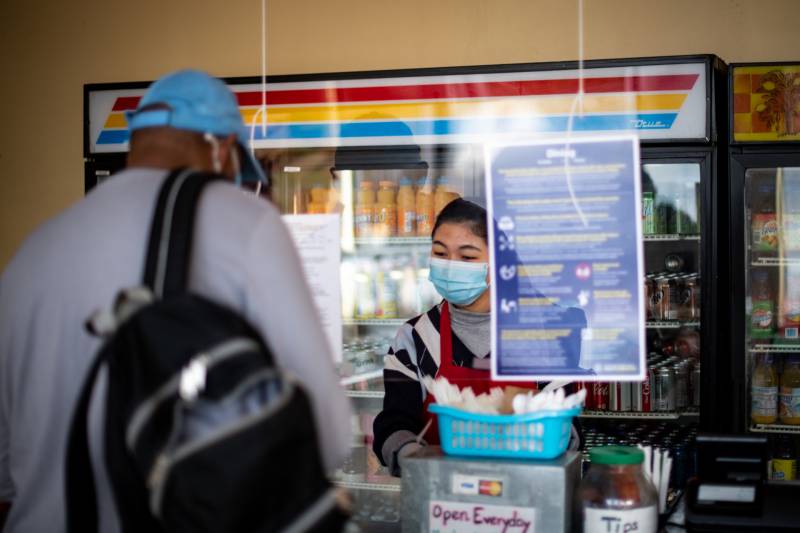Now that Santa Clara County has announced it'll drop its mask mandate and align with the state, starting March 2 most of the Bay Area will be aligned with the state's new masking guidance. Both vaccinated and unvaccinated Californians may now take off their masks in most indoor public settings, including stores, restaurants, gyms and movie theaters.
We’ll continue to closely monitor whether counties will further update their guidance.
Keep reading to find the county where you live, work or study for the latest masking rules, or use the links below — and bookmark this page for updates to mask mandates in the Bay Area.
- Skip to your Bay Area county:
Alameda | San Francisco | Contra Costa | Marin | Napa | San Mateo | Santa Clara | Sonoma | Solano
Mask mandates in Bay Area counties
Alameda
On Thursday, June 2, Alameda County health officials announced they were reinstating a mask mandate for most indoor public settings beginning on June 3, regardless of vaccination status.
The new health order does not apply to the city of Berkeley, which has its own public health department.
This means both unvaccinated and vaccinated people are once again required to wear masks in most indoor public spaces, including businesses, restaurants and bars, government offices, public transportation, bus and train stations, hospitals and correctional centers.
An existing indoor mask mandate remans in effect for health care settings, congregate settings like correctional facilities and homeless shelters, and long-term care facilities, and in K-12 schools and child care settings.
An earlier indoor mask mandate at all schools that are part of Berkeley Unified School District began May 23. District officials announced this change on May 20 and added that BUSD " is experiencing an increase in the number of classroom clusters which indicate likely transmission in school."
The mask mandate for BUSD schools will be in place until the end of the 2021-2022 school year.
San Francisco
On June 2, following Alameda County's announcement of a renewed indoor mask mandate, San Francisco officials told KQED that they don't have plans to reinstate a similar mask mandate at this time.
As of Feb. 16, people who are up to date with their eligible COVID-19 vaccinations — this includes booster shots if you currently qualify — can take their masks off in indoor public spaces in San Francisco. Officials confirmed that San Francisco aligned with the state's guidance to extend this to unvaccinated people as of March 1.
Indoor masking is still required for everyone — regardless of vaccination status — in health care settings, congregate settings like correctional facilities and homeless shelters, long-term care facilities, and in K-12 schools and child care settings.
Contra Costa
On June 2, following Alameda County's announcement of a renewed indoor mask mandate, Contra Costa County officials told KQED that they don't have plans to reinstate a similar mask mandate at this time.
Contra Costa County lifted universal mask requirements for most indoor public settings in the county starting Feb. 16. Contra Costa confirmed it's alignment with the state's guidance to extend this to unvaccinated people as of March 1.
This means people no longer have to wear masks in indoor public spaces, although indoor masking will still be required for everyone — regardless of vaccination status — in health care settings, congregate settings like correctional facilities and homeless shelters, long-term care facilities, and K-12 schools and child care settings.
Marin
On June 2, following Alameda County's announcement of a renewed indoor mask mandate, Marin County officials told KQED that they don't have plans to reinstate a similar mask mandate at this time.
Marin lifted universal mask requirements for most indoor public settings in the county starting Feb. 16. Marin confirmed it's alignment with the state's guidance to extend this to unvaccinated people as of March 1.
This means people no longer have to wear masks in indoor public spaces, although indoor masking will still be required for everyone — regardless of vaccination status — in health care settings, congregate settings like correctional facilities and homeless shelters, long-term care facilities, and K-12 schools and child care settings.
Unvaccinated individuals over age 2 will continue to be required to wear masks in all indoor public settings in Marin County.
Napa
Napa County has announced it will follow the state and lift universal mask requirements for most indoor public settings in the county starting Feb. 16.
This means people no longer have to wear masks in indoor public spaces, although indoor masking will still be required for everyone — regardless of vaccination status — in health care settings, congregate settings like correctional facilities and homeless shelters, long-term care facilities, and K-12 schools and child care settings.
San Mateo
On June 2, following Alameda County's announcement of a renewed indoor mask mandate, San Mateo County officials told KQED that they don't have plans to reinstate a similar mask mandate at this time.
The county followed state guidance and lifted universal mask requirements for vaccinated people in most indoor public settings since Feb. 16, and extended that guidance to unvaccinated people as of March 1.
This means people no longer have to wear masks in indoor public spaces, although indoor masking will still be required for everyone — regardless of vaccination status — in health care settings, congregate settings like correctional facilities and homeless shelters, long-term care facilities, and K-12 schools and child care settings.

